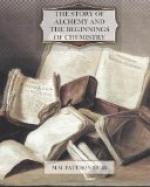I have always regarded two facts as most interesting and instructive: that the doctrine of the essential unity of all things, and the simplicity of natural order, was accepted for centuries by many, I think one may say, by most men, as undoubtedly a true presentation of the divine scheme of things; and, secondly, that in more recent times people were quite as certain of the necessary truth of the doctrine, the exact opposite of the alchemical, that the Creator had divided his creation into portions each of which was independent of all the others. Both of these schemes were formed by the same method, by introspection preceding observation; both were overthrown by the same method, by observation and experiment proceeding hand in hand with reasoning. In each case, the humility of science vanquished the conceit of ignorance.
The change from alchemy to chemistry is an admirable example of the change from a theory formed by looking inwards, and then projected on to external facts, to a theory formed by studying facts, and then thinking about them. This change proceeded slowly; it is not possible to name a time when it may be said, here alchemy finishes and chemistry begins. To adapt a saying of one of the alchemists, quoted in a former chapter; alchemy would not easily give up its nature, and fought for its life; but an agent was found strong enough to overcome and kill it, and then that agent also had the power to change the lifeless remains into a new and pure body. The agent was the accurate and imaginative investigation of facts.
The first great step taken in the path which led from alchemy to chemistry was the substitution of one Principle, the Principle of Phlogiston, for the three Principles of salt, sulphur, and mercury. This step was taken by concentrating attention and investigation, by replacing the superficial examination of many diverse phenomena by the more searching study of one class of occurrences. That the field of study should be widened, it was necessary that it should first be narrowed.
Lead, tin, iron, or copper is calcined. The prominent and striking feature of these events is the disappearance of the metal, and the formation of something very unlike it. But the original metal is restored by a second process, which is like the first because it also is a calcination, but seems to differ from the first operation in that the burnt metal is calcined with another substance, with grains of wheat or powdered charcoal. Led thereto by their theory that destruction must precede re-vivification, death must come before resurrection, the alchemists confined their attention to one feature common to all calcinations of metals, and gave a superficial description of these occurrences by classing them together as processes of mortification. Sulphur, wood, wax, oil, and many other things are easily burned: the alchemists said, these things also undergo mortification, they too are killed; but, as “man can restore that which man has destroyed,”




